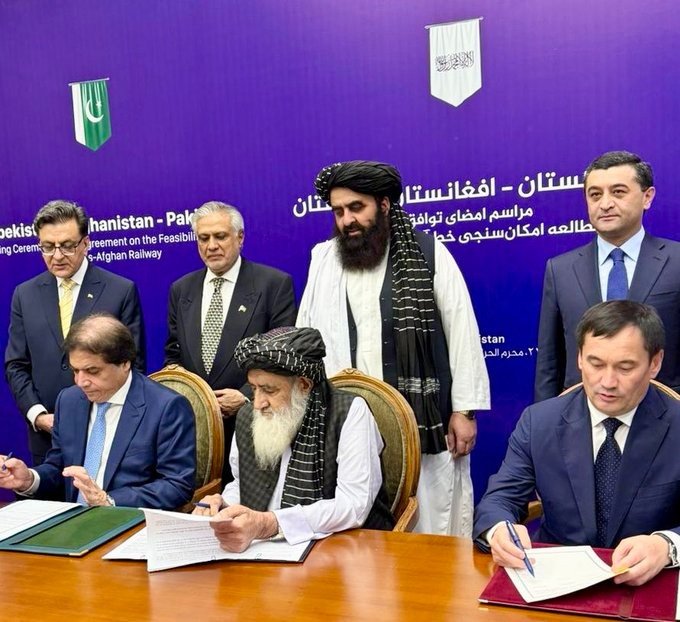
In a landmark development for regional connectivity, Pakistan, Uzbekistan, and Afghanistan signed the Framework Agreement on the Joint Feasibility Study for the Uzbekistan–Afghanistan–Pakistan (UAP) Railway Project on Thursday in Kabul.
The trilateral deal marks a pivotal moment in the long-envisioned goal of linking Central Asia to Pakistan’s Arabian Sea ports, transforming the region into a critical hub for trade and transit.
Deputy Prime Minister and Foreign Minister Ishaq Dar, who led the Pakistani delegation to Kabul, announced the signing via a post on X (formerly Twitter), congratulating the three nations and commending the efforts of the Uzbek and Afghan foreign ministers for their commitment to regional cooperation.
“We remained closely engaged throughout the negotiation process to finalize the details,” Dar stated. He was accompanied by Railways Minister Hanif Abbasi, Pakistan’s Special Representative for Afghanistan, and the Secretary of the Ministry of Railways.
A Strategic Corridor for Central and South Asia
Originally conceptualized in 2021, the UAP railway corridor spans approximately 850 kilometers (528 miles) and is projected to connect Tashkent to Peshawar via Termiz (Uzbekistan), Mazar-i-Sharif and Logar (Afghanistan), and the Kharlachi border crossing in Khyber Pakhtunkhwa, Pakistan. The corridor aims to serve both freight and passenger services and is expected to reduce transit times by at least five days while cutting transportation costs by up to 40 percent.
The railway, estimated at $4.8 billion, will provide landlocked Central Asian states direct access to Pakistan’s deep-sea ports in Karachi and Gwadar, thereby opening up the Indian Ocean for regional trade.
From Vision to Implementation: Key Milestones and Challenges
The project has seen several hurdles since its first roadmap was signed in Tashkent in February 2021. Construction, originally slated for September 2021, was delayed due to the Taliban’s return to power in Afghanistan. However, by mid-2022, the de facto Afghan government had rejoined the project, and expeditionary work commenced to assess the most viable routes.
Despite this progress, technical and security challenges persist. A major concern is the incompatibility of rail gauges among the three countries. While nearly all political and financial frameworks are in place, agreement on a standard gauge system remains elusive. Additionally, the corridor passes through some of the most volatile regions of Afghanistan and Pakistan, raising concerns about militant activity, particularly from groups like ISKP in Afghanistan and insurgents in Khyber Pakhtunkhwa.
Nevertheless, during a bilateral meeting on July 7 in Islamabad, Pakistan and Afghanistan reaffirmed their commitment to overcoming terrorism and enhancing regional connectivity. The thaw in relations between Islamabad and Kabul may prove instrumental in keeping the momentum alive.
Kazakhstan Joins In: Toward a Trans-Afghan Multimodal Corridor
Parallel to the UAP railway project, a Trans-Afghan Multimodal Corridor is beginning to take shape. In collaboration with Pakistan’s National Logistics Corporation (NLC), Kazakhstan Railway’s KZT Express, and QazTrade, this corridor facilitates multimodal shipments from Kazakhstan through Uzbekistan and Afghanistan to Pakistan, extending onward to the UAE’s Jebel Ali port.
A recent pilot shipment from Pavlodar Special Economic Zone in Kazakhstan to Karachi took just 20 days, followed by shipping to Dubai in two more days. Another cargo successfully traveled from Karachi to Azerbaijan, crossing Afghanistan, Uzbekistan, and Kazakhstan, and then ferrying across the Caspian Sea to Baku, covering over 4,800 km in 21 days.
The results are promising. Over 60 containers are expected to follow this route in the coming months, signaling growing confidence in the corridor’s viability. Pakistan’s TIR (Transports Internationaux Routiers) operators, including TCS, are also playing a key role in facilitating this trade.
Geoeconomics in Motion: Regional Players Step Forward
The UAP and Trans-Afghan corridors are not isolated initiatives. In April 2024, Kazakhstan and Uzbekistan signed a joint venture to integrate their rail systems through Afghanistan. Kazakhstan has also committed to supplying materials for railway construction, including sleepers and fasteners.
Further, in May 2024, transport ministers and logistics stakeholders from Russia, Belarus, Kazakhstan, Uzbekistan, Afghanistan, and Pakistan convened in Termiz to discuss digitalizing routes, harmonizing tariffs, and establishing a consortium to manage the corridor. The anticipated freight capacity is 20 million tons annually, connecting Europe, South Asia, the Middle East, and beyond.
What’s at Stake?
For Pakistan, these transport corridors represent a game-changing opportunity to emerge as a transit gateway for Central Asia. For landlocked countries like Uzbekistan and Kazakhstan, they offer a lifeline to global trade networks. The railway’s success could reshape regional supply chains, drive economic integration, and enhance people-to-people connectivity.
Still, significant hurdles remain—from technical rail gauge disparities to volatile border regions and fragile political alliances. Yet, with the Framework Agreement now signed, optimism is growing.
If successfully implemented, the UAP Railway Corridor and the broader Trans-Afghan Multimodal Network could mark the beginning of a new economic era for the heart of Asia. – ERMD
